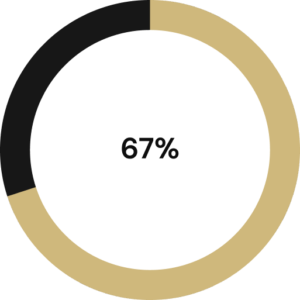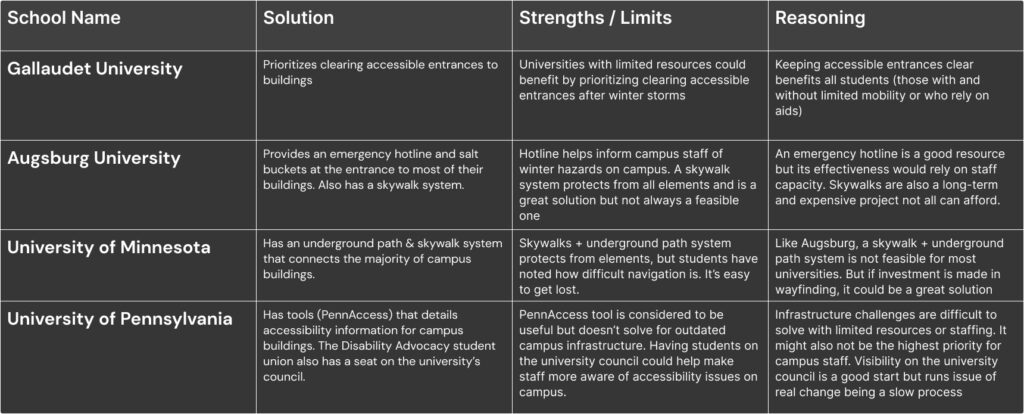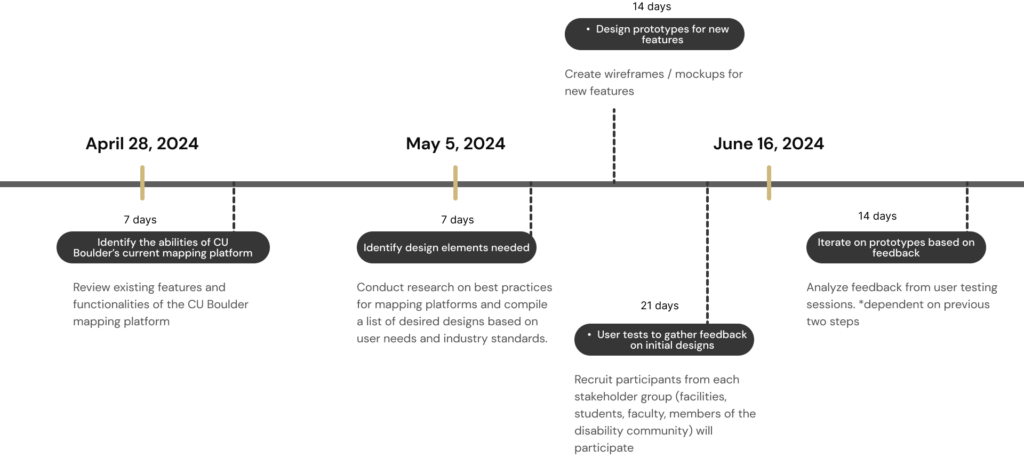
Winter Barriers to Campus Accessibility
Project Scope
Client
CU Boulder
Methods
Secondary Research, Observations, Interviews
Duration
6 months
My Role
UX researcher
Team
Me
Urban Planner
UX Designer
Economist
Background
Within the United States, educational institutions must ensure buildings have accessible entrances as outlined in the Americans with Disabilities Act (ADA). As a leading public university, CU Boulder has a population of over 36,000 undergraduate students, over 4,000 of which registered for disability accommodations in 2022. In Boulder, an average of 23% of days between October and April have an inch or more of snow on the ground. While buildings on campus have been retrofitted or constructed with features like ramps to comply with ADA requirements, this improved accessibility infrastructure is futile if snow and winter hazards prevent mobility-impaired community members from navigating campus paths at all.
Percentage of CU Boulder buildings constructed before the Americans with Disabilities Act in 1990

Need Statement
Address non-functioning accessible entrances and routes on CU Boulder’s campus due to winter hazards so that all people can access buildings regardless of their mobility level.
Existing Solutions

Gallaudet University

Solution: Prioritizes clearing accessible entrances to buildings
Strengths/Limits: Universities with limited resources could benefit by prioritizing clearing accessible entrances after winter storms
Augsburg University

Solution: Provides an emergency hotline, salt buckets, and a skywalk system.
Strengths/Limits: Hotline and salt buckets are affordable options, and skywalks protects from all elements. However, skywalks are costly and not feasible for all.
University of Minnesota

Solution: Has an underground path & skywalk system that connects the majority of campus buildings.
Strengths/Limits: Skywalks + underground path system protects from elements, but students have noted how difficult navigation is. It’s easy to get lost.
University of Pennsylvania

Solution: PennAccess tool details accessibility information for campus buildings. The Disability Advocacy student union also has a seat on the university’s council.
Strengths/Limits: PennAccess tool is considered to be useful but doesn’t solve for outdated campus infrastructure. Having students on the university council could help make staff more aware of accessibility issues on campus.
Target Users
The project focuses on students with mobility challenges who depend on mobility aids, including wheelchairs, crutches, or walkers, to maneuver around campus.
Partnership with facilities management to provide their team with critical and timely information so hazards can be addressed.
SWOT Analysis
Helpful to achieving objective
- Individual students will have important voice in sharing experience. Influence public perception and policy
- Can directly respond to and address hazardous weather events when they occur
- Significant knowledge about disability rules and requirements
- Involved in future infrastructure planning and architecture. Long-term solutions
- Directly involved in advocating for students with disabilities. Knowledge of behavior and campus environment
- May advocate for students with disabilities. Boulder community values campus mobility.
- Have the power to organize timely and effective responses to winter conditions
- Able to bring diverse groups together. Influence attitude and policy around campus mobility.
Unhelpful to achieving objective
- May only provide assistance on interventions that are legally necessitated
- Less influence on day to day campus changes/improvements
- Low agency in addressing barriers for building access and walking paths. May defer to Disability Office for decision making.
Potential Opportunities
- Reach out to individual students with disabilities, gather experience, help them advocate
- Backing from the disability office could add urgency to these efforts
- Could be involved in long-term architectural plan to improve disability access during winter
- Individual faculty and staff could represent important voices in communicating challenges for students on campus
- Emergency management communication with other stakeholders could be improved to respond effectively to winter mobility challenges
- Able to provide insight on latest technologies and products to address specific problems
Potential Threats
- CU Infrastructure Department is large. Many players. Potentially difficult to know who can make decisions/improvements
- New laws and regulations take time. Even if passed, may not address problem
- Low decision making power. May not be helpful in supporting long-term solutions. May not have staffing or funding to respond to increased demand.
Gap Analysis

Need Criteria
Must Haves
- Fits into current workflow, capacity, and budget of Facilities Maintenance Office
- Low maintenance requirement once established
- Intuitive and easy to use, fewest number of failed use attempts possible
- All weather accessibility solution
Nice to Haves
- Responsive to comments of disabled community at CU
- Works on every accessible path/entrance on campus
- Requires minimal effort on the part of CU’s disabled community
Proposed Solution
Drawing inspiration from Colorado’s road conditions map, our solution is to create enhancements to the existing CU Boulder interactive map to represent the real time conditions of localized paths and entrances during inclement weather.

Project Goal & Implementation
The primary goal of this project is to update the current interactive CU Boulder campus map to include additional features that support students with disabilities.
To achieve this, we will implement several features:
- Real-time conditions of localized paths and entrances during inclement weather
- Method for gathering feedback from campus community for real-time obstacle reporting
- Real-time weather reporting within a two hour margin
By developing these mapping features, we hope to improve the reported satisfaction of people with mobility challenges as they plan a route and navigate campus during poor weather conditions.
Project Milestones


Budget & Timeline
Following our activity plan, we anticipate the following budget and timeline for this project:
- Total project length is expected to take 3 months to complete
- Project will begin on April 28th, 2024 with the review of CU Boulder’s current mapping functionalities and features
- Project will end on August 1st, 2024 with a communications plan to inform stakeholders of the product release
- The total project budget is $72,000. This includes:
- $58,000 for internal team funding
- $10,000 for CU Boulder staff supporting integration of the platform,
- $200 for user incentive during participatory testing phase
- $3,280 for distribution of promotional materials around campus
- Remaining budget will go towards software and office supplies
Monitoring & Evaluation Plan
The project will be monitored and evaluated based on below five categories:
Impact
Has there been a measurable decrease in mobility related incidents on campus during winter months since the mapping platform has been implemented?
Effectiveness
How effectively does the new mapping platform allow students with disabilities to plan their campus routes during winter months?
Efficiency
Are there any features within the mobility mapping platform that could be improved or streamlined to enhance efficiency?
Relevance
Are the mapping features and navigation capabilities relevant for students with disabilities? Do they address the challenges experienced by students with disabilities on campus?
Sustainability
What plans and budget are in place to ensure the long-term maintenance of the new mapping platform?